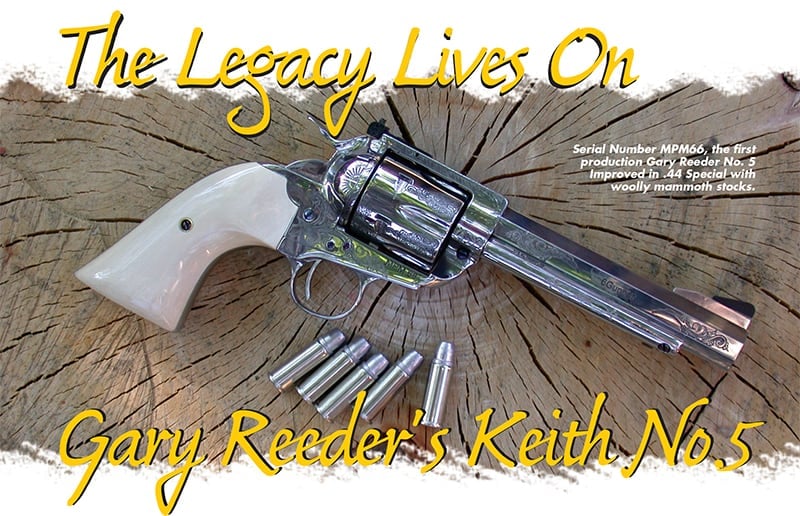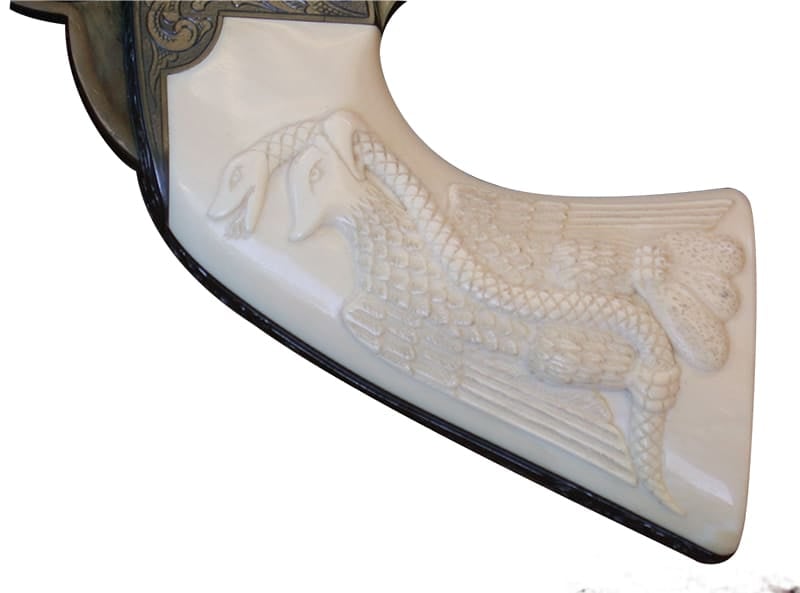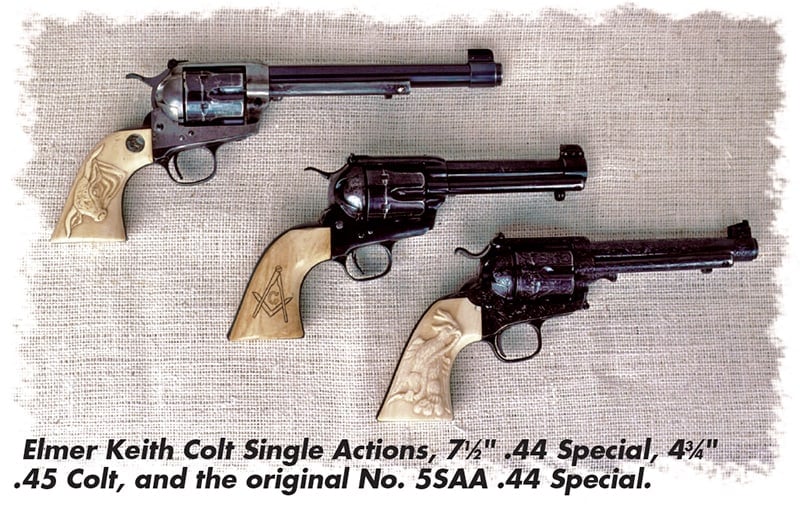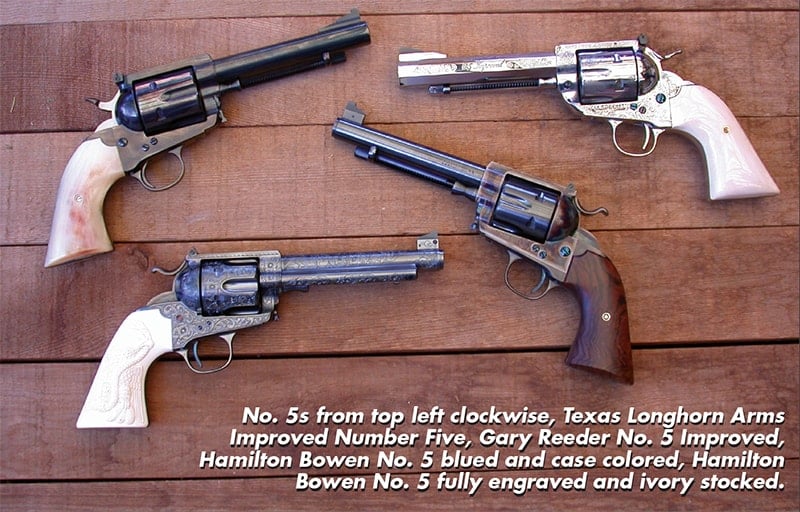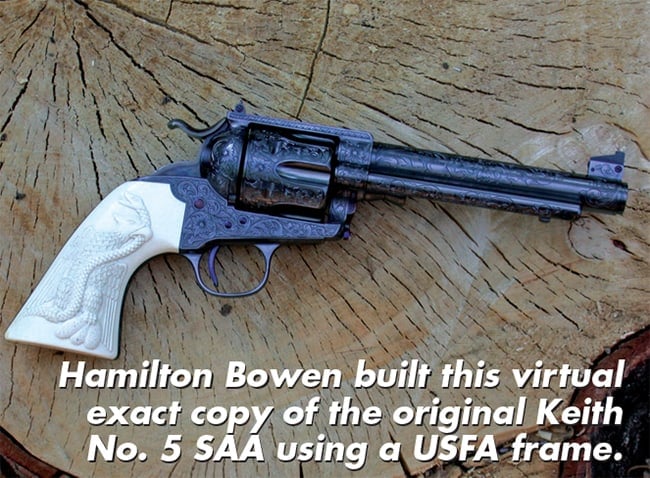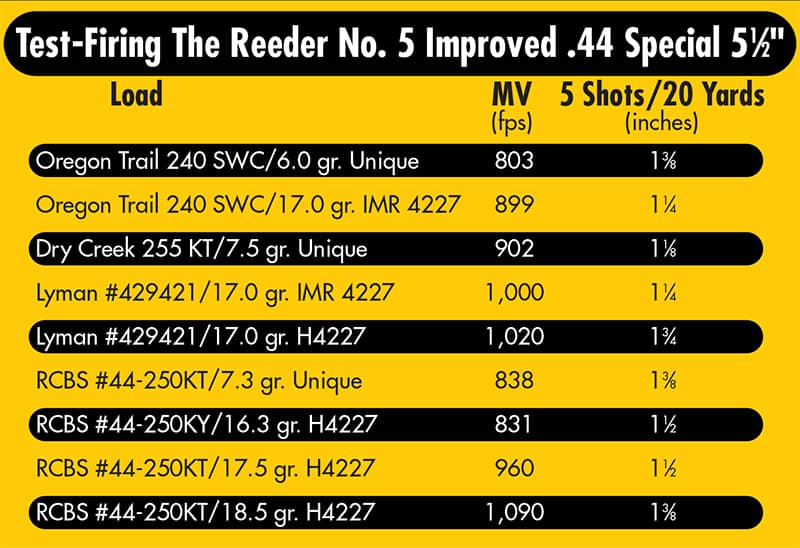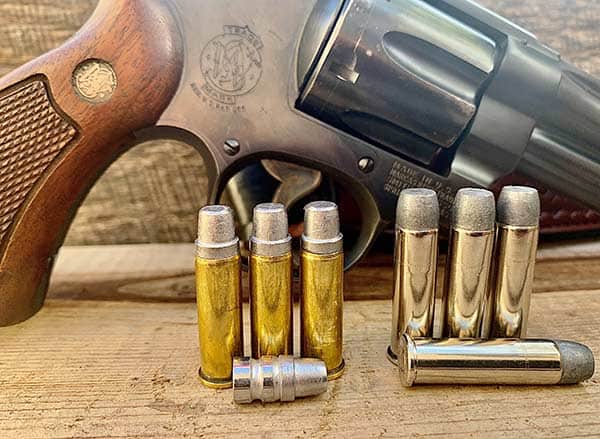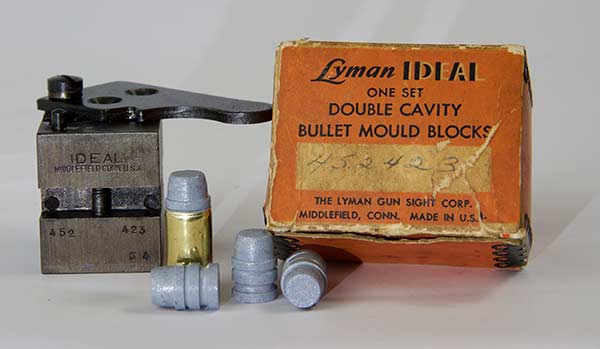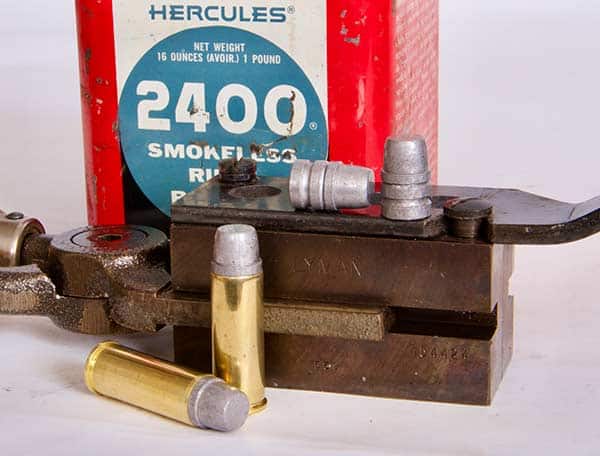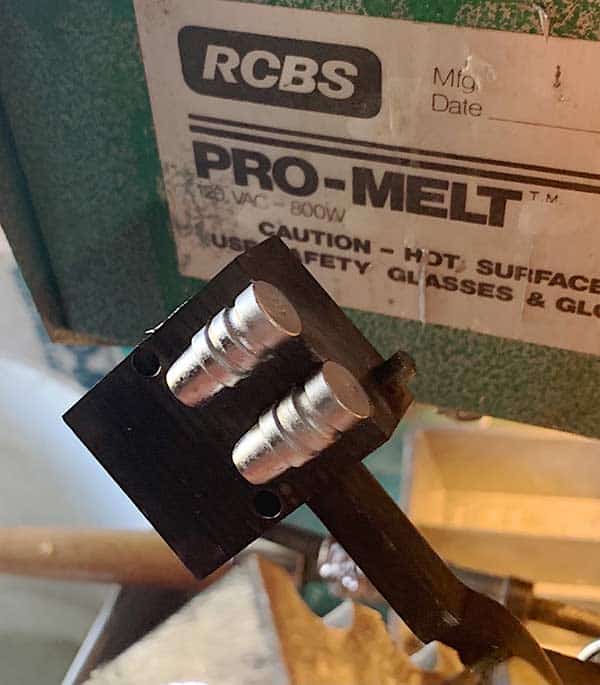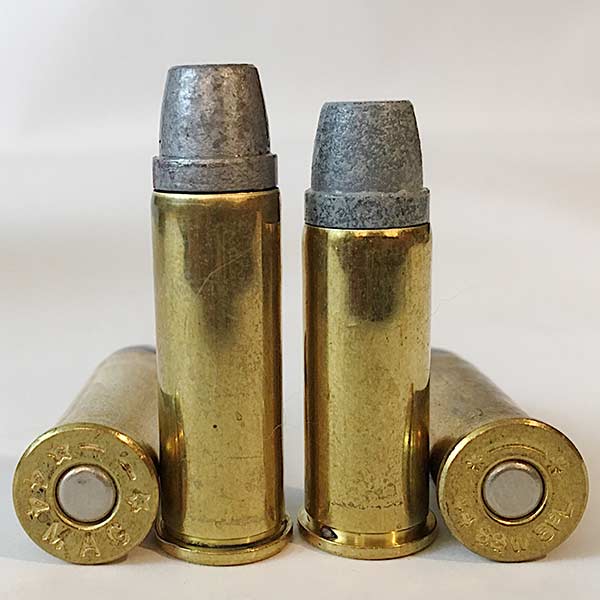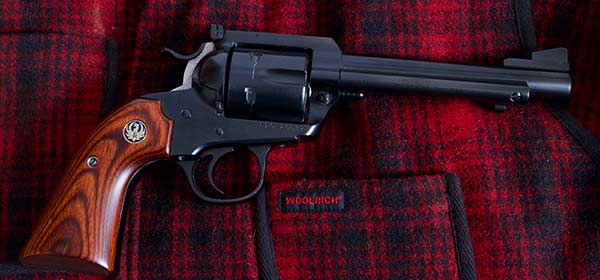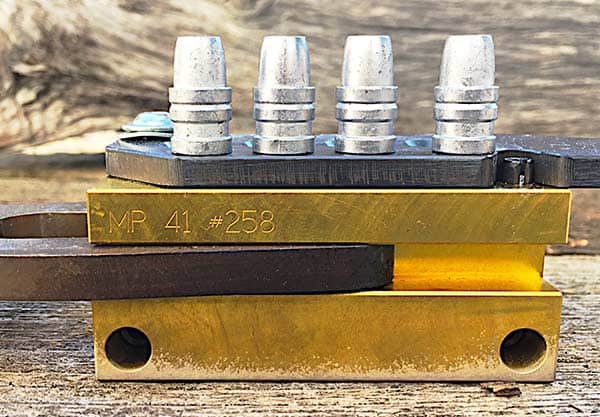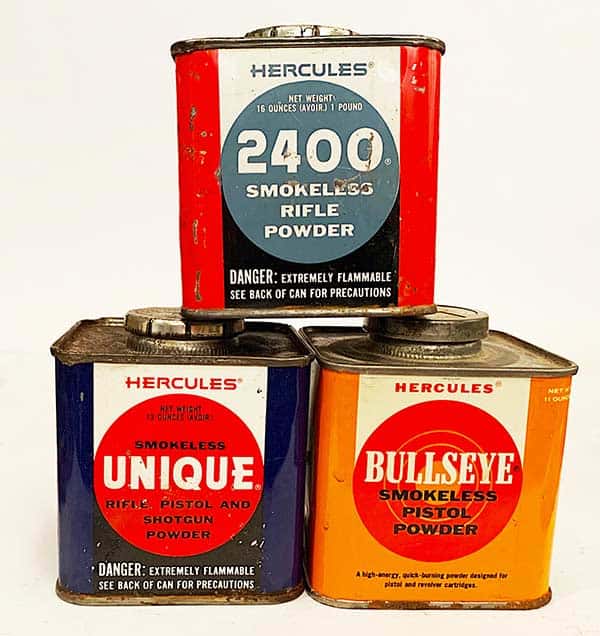Category: Ammo
THE LEGACY LIVES ON BY JOHN TAFFIN
Let’s go back in time. “Even in 1928 when Harold Croft of Philadelphia visited me for a month at my little ranch in Durkee, Oregon, he told me frankly, when I met him at the station, that everyone he knew in the revolver clubs in the East had asked him to find out if the long-range sixgun work I had written of was true; all firmly believing it was not.
Croft witnessed my hitting a four-foot square target at 700 yards with every sixgun save one of the suitcase-full he brought along, before said gun was empty. The one exception was a 2″- barreled .45 Colt slip gun. Croft also witnessed my killing several jack rabbits at 125 to 150 yards, as well as hitting one eagle at 200 yards, with .44 Special SA Colts.” (American Rifleman, May 1939)
Easy As 1, 2, 3, 4
Croft, described by Keith as a gun crank and collector, hit it off famously with the cowboy. Croft was a dedicated sixgunner and designer and brought four special lightweight sixguns to show to and shoot with Keith. These were all built on Colt Single Actions and Bisleys and basically designed primarily as lightweight self-defense single actions. These four sixguns were numbered 1, 2, 3 and 4.
Keith liked the sixguns that Croft had designed and saw real possibilities with Croft’s designs, not in a lightweight pocket sixgun but as a full-sized single action .44 Special: “Needless to say, after playing with Croft’s guns awhile I decided to have one of my SAA guns worked over to incorporate some of Croft’s improvements, with a few ideas of my own thrown in,” said Keith. The result was the famous Number 5 Single Action Army pictured in many of Keith’s articles over the next 30 years, as well as in Sixguns.
All Add Up
Keith wrote about The Number 5 SAA .44 Special in the April 1929 issue of The American Rifleman in an article entitled “The Last Word.” The Number 5 SAA was truly “The Last Word” in sixguns for nearly 60 years, until the coming of the Freedom Arms Model 83, the Texas Longhorn Arms Improved Number Five, and the custom revolvers of such masters of the sixgun as Hamilton Bowen, John Linebaugh, Jim Stroh and Andy Horvath.
Keith’s Number 5 SAA was basically a Colt SA with a Bisley backstrap and a Single Action Army front strap. Grips were ivory, barrel length was 51⁄2″, sights were fully adjustable, the base pin was over-sized, and the cylinder pin catch was a masterful design operating on the lever principle. The chambering was .44 Special and for the next 30 years the .44 Special would be Keith’s caliber. His favorite load was a 250-grain hard cast bullet of his design over a heavy load of #80 powder, which was soon replaced by the then new #2400.
His load with the latter powder was 18.5 grains in balloon head brass. When the modern solid brass appeared in the 1950s, Keith’s standard load was lowered to 17 grains of #2400. Both of these loads are heavy and should be used with caution only in heavy-framed modern .44 Special sixguns such as the Colt Single Action Army, New Frontier or Smith & Wesson Model 24. Velocity is around 1,200 fps. With today’s #2400 16.0 grains will give the same results as Keith obtained with 17.0 grains.
Carrying On The Legacy
Elmer Keith may be gone, however the legacy of the No. 5 SAA lives on. Gary Reeder has reached back in time and is now offering a thoroughly modern No. 5 Improved based on Elmer’s No. 5 as it appeared in the 1929 American Riflemen. Modern touches include better sights, micro-style rear with interchangeable front blades and a transfer bar safety conversion combined with a standard single action style action with a half cock notch. The loading gate is opened and the hammer put on half cock for loading and unloading even though it has a transfer bar safety.
It was my good fortune to test the prototype No. 5 Improved, one of the most beautiful sixguns ever offered by Gary Reeder. The 6″ Deluxe Grade all-steel prototype is high polished stainless steel highlighted by bright blue screws, engraved, with a deep muzzle crowned octagonal barrel, chambered in .44 Special and stocked with elephant ivory.
There is one major change of the Reeder No. 5 compared to the Keith No. 5. Grover duplicated Keith’s Number 5 grip frame, however Keith had very small hands, which is evident in his grip frame. Reeder maintained the same basic grip frame making it more useable by adding three-eighths of an inch to the length.
The triggerguard and the hammer of the No. 5 Improved are both beautifully shaped with the triggerguard smaller than standard and beautifully rounded, however it is overshadowed by the stylishness of the hammer. The profile whether from the side with its very slim look or from the top with its beautifully shaped spur will stir a sixgunner’s soul and when cocked, the back of the hammer beautifully flows along the backstrap.
The prototype No. 5 Improved had to be sent back with me fully intending to order a No. 5 .44 Special later. Before I could act, Diamond Dot, (can you guess what she collects?) got together with Gary Reeder and ordered a very special No. 5 Improved and I now have one of the first two production No. 5 Improved .44 Specials. It will be available in .45 Colt and .41 Special also. A few changes have been made.
Instead of a 6″-barrel, this first of what will probably be many No. 5 Improved sixguns has the more eye-pleasing (to me) 51⁄2″-barrel, stocks are certificated 20,000-year old woolymammoth ivory out of Russia with a heart-stopping creamy smooth texture, and the serial number has special significance being MPM66 (See GUNS Campfire Tales, April 2005).
What makes it even more special is the fact Diamond Dot plotted with Gary Reeder to have this first production No. 5 Improved .44 Special put together for my birthday. I don’t know which of the two of them made the decisions as to barrel length and caliber but they did goooood! The wooly-mammoth ivory and engraving are just added icing on the cake.
Going A Step Farther
Keith found the .44 Special was just what he needed in the 1920s. With the coming of the .44 Magnum in late 1955 Keith basically retired his .44 Specials and spent the rest of his life almost exclusively with the .44 Magnum. He mostly carried a 4″ S&W .44 Magnum on a daily basis, however preferred the 61⁄2″ Smith & Wesson or the 71⁄2″ Ruger Super Blackhawk for hunting.
Keeping The Torch Aflame
From Croft to Reeder has been a path of 80 years. That’s a long time in sixgun history. The legacy of the No. 5 and the greatness of the .44 Special live on; I’ve shot everything there is to shoot caliber- and cartridge-wise, however the .44 Special was my first love way back in the 1950s and I now find myself shooting it more and more. It suits me just fine. The .44 Special is fast approaching the century mark and at this stage of my life I find anything I would want to hunt in the lower 48 can be cleanly taken with the .44 Special.
From the 1920s to the 1950s, Keith extolled the virtues of the .44 Special; Skeeter Skelton picked up the torch in the 1960s and carried it almost 30 years. I am now in special company spotlighting the .44 Special along with Clint Smith, Brian Pearce and Mike Venturino. We will do our best to keep the legacy moving forward. The Reeder No. 5 Improved will play a large part of my role with the .44 Special.
In addition to the production No. 5 offered by Gary Reeder, Hamilton Bowen is part of the legacy also. He is offering high-grade No. 5 SAA conversions on USFA frames chambered in, of course, .44 Special. Brian Pearce just stopped over and brought examples of Bowen’s work, a blued/case colored No. 5 everyday workin’ and a fully engraved, ivory stocked No. 5 that is virtually a duplicate of Elmer Keith’s original No. 5 complete with Keith’s choice of the Mexican eagle carving on the grips. In place of the Masonic emblem on the top strap of Keith’s No. 5 SAA, Brian has his name and along with Hamilton Bowen as the creator of this historic recreation.
He also brought a very special gift. Brian has visited the old ranch site in Durkee, Oregon and brought back a three foot piece of an old poplar tree, the same tree Keith and Croft sat under for shade as they shot long range. Brian understands. That piece of old wood is now nestled on the mule deer rack above my desk. If you don’t understand that there is no way I can explain it.
Looking back is supposedly bad because you just might see something gaining on you. I’ve always enjoyed a daredevil demeanor and the potential risks when peering back to our mentors. Doing so allows one to grab a glimpse into the future. Walking in the same boots of past pioneers gives us a chance to experience their findings firsthand, be it for better or worse. What can we expect by doing such things? It may help explain why the men did what they did, with what they had at hand.
By examining the components available, we learn some of the loads Elmer Keith came up with yesterday are still as useful and pertinent today. Some of these loads are timeless. We have a lot to be thankful for with men like him.
Keith had a knack of making cartridges more versatile by loading them to different power levels. As you’ll notice, most of these cartridges have three loads. A heavy load, a medium use everyday load, and a lighter “target” load. Such loads allowed a power continuum for an intended purpose. Pretty savvy for back in the day, and one just as useful today. There’s no need to load/shoot barnburner handloads all the time.
.45 Auto Rim
Keith designed Ideal mold 452423 to be cast hard, 1 to 10 tin/lead, weighing 235 grains, so it would hold the shallow rifling found in 1917 revolvers. He used 7.5 grains of Unique for a medium, everyday load and 14 grains of 2400 for a heavier hunting load. Also, 5 grains of Bullseye was his pet target load, shooting very accurately with light recoil.
Later, he figured out his 454424 .45 Colt slug, which weighed 250 grains also shot very well in the .45 Auto Rim when sized .451 while using the same powder charges for the Ideal 452423.
.45 Colt
Using Ideal #454424, Keith went with 5-6 grains of Bullseye for his light target loads, 10 grains of Unique for heavier, everyday loads and 18.5 grains of 2400 for full-power hunting loads. He stated the full house loads should only be loaded in smokeless powder designed guns, or guns with modern steel cylinders.
This bullet is a favorite of mine and I have taken numerous deer and a cow elk using it. Using large-framed Ruger single actions and Redhawks, I up the charge of 2400 to 20 grains of 2400, just as Keith did.
.38 Special
Keith’s Ideal 358429 was designed to be used in .38 Special cases, as the .357 Magnum had not been designed yet. No matter, Keith’s initial load of 13.5 grains of 2400 with his slug was perfect for Heavy Duty N-frame S&W guns, such as the adjustable sighted Outdoorsman and fixed sighted Heavy Duty.
Keith’s load was essentially a magnum load in .38 Special brass. Today’s 2400 is slightly faster, and maximum loads should not exceed 13.0 grains of 2400, with a small pistol primer. My guns average 1,260 FPS with this load with exceptional accuracy. With .38 Special cases more abundant than .357 Magnum, you won’t miss the Magnum with this load at all. I’ve basically shot thousands of this load over the years in magnum sized guns with happy results.
.44 Special
Keith designed the Lyman/Ideal 429421 for the .44 Special in the early 20s. He enjoyed 5 grains of Bullseye for a gallery load, 7.5 grains of Unique for a medium load and 17 grains of 2400 for his heavy load. You may recognize the Unique load as “the Skeeter Load” and you’re right. Skeeter obtained this load from Keith. The heavy .44 Special load was the impetus for the .44 Magnum.
.44 Magnum
After shooting heavy .44 Special loads for years, Keith petitioned Remington and S&W to make his hot loaded .44 Specials a factory offering. He wanted them to duplicate his 1,200 FPS loading. It’s all he wanted.
The folks at Remington were worried about his high-pressure loads being shot in older guns. Remington remedied this by using a case 1/10” longer than .44 Special brass, making it impossible to load in .44 Special guns.
Carl Hellstrum of S&W agreed to build a gun around any load Remington would bring out. Remington’s load reached 1,400 FPS, using a soft lead gas checked slug.
Keith developed perhaps his most famous load, 22 grains of 2400, with his 250 grain 429421 slug, ignited with a standard large pistol primer. Velocities run around 1,400 FPS, depending on barrel length. With today’s 2400, this load should be dropped to 21 grains of 2400 to reach the same velocities
.41 Magnum
Keith never designed Lyman’s 410459 mold made for the .41 Magnum. It’s a common assumption and mistake made by many. However, he did design a bullet for Hensley & Gibbs, weighing 230 grains.
The Hensley & Gibbs #258 mold has all the qualities Keith desired for his cast bullets. His light load consisted of 4 grains of Bullseye, 7.5 grains of Unique for a heavier load, and 19 to 20 grains of 2400 for a heavy load. This last load goes between 1400-1500 FPS, depending on barrel length.
Keith took 5 caribou with the pair of 4” S&W model 57s given to him by S&W and Remington soft-nosed factory ammo. He claimed the .41 Magnum shot flatter than his .44 Magnum load.
An Alliant Alliance
By using the old Hercules powders, now made by Alliance, we can still handload powerful, useful cartridges for hunting, light, plinking loads for target, or introducing someone to handgunning, or moderate, everyday field loads that can basically handle any chore.
The fact they were Elmer Keith’s pet loads makes us feel closer to him every time we pull the trigger and have one of his cast bullet designs strike its intended target as they have been doing for over 100 years now. And that my friends, is pretty darn cool.
****************************************************
Hey don’t blame me if your gun blows up & ends the world by using this stuff! I just put this out for amusement purposes only!!!!!!!!!!!!! GRUMPY
******************************************************
And in rebuttal –
